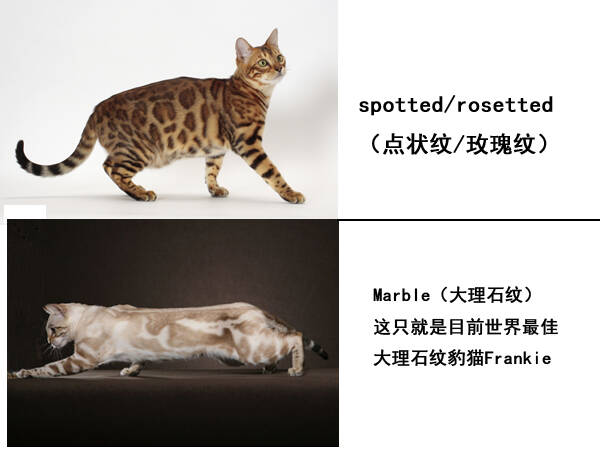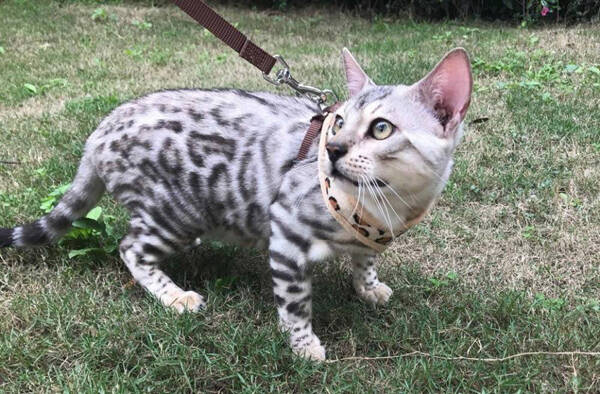Bengal Cat
IUCN
LCBasic Information
Feature
Gentle yet with the wild beauty of an ocelot
Distribution and Habitat
Originated from the United States
Appearance
The head is broad, modified wedge-shaped, with rounded outlines. The head is long in length and narrow in width. The head is slightly small in proportion to the body, but not too small. The skull forms a gentle curve behind the ears and slopes down to the neck. The jaws of adult male cats are broad. The head should have a wilder appearance than other domestic cats.
Details
The term "leopard cat" actually refers to two types of cats. One is the wild Asian leopard cat (a small wild cat with leopard-like patterns), and the other is a new breed of domestic cat produced by cross-breeding between Asian leopard cats and domestic cats. The leopard cats we refer to here all refer to this new breed of domestic cats (strain breed cats SBT--that is, the new breed of domestic cats recognized by TICA), so our "leopard cats" are not wild animals. Our leopard cats have the bloodline of Asian leopard cats, and have leopard patterns that are even more beautiful than those of Asian leopard cats, wild appearance, and superb jumping and climbing abilities. However, because they have been cross-bred with domestic cats or SBT for at least four generations, they are no longer wild and have become pet cats suitable for family breeding. So in order to distinguish, the one suitable for family breeding is called Bengal cat (bengalcat). However, many people like to use the abbreviation, but considering pets, these two names refer to the same thing, both of which refer to Bengal cats. From an zoological perspective, they are not the same species. Bengal cats are pet cats, while leopard cats are wild cats.

Bengal cats have two basic patterns: Spotted and Marble. Rosette is derived from Spotted. The so-called rose pattern refers to a large area of dotted decoration, but its edge and internal color have a strong contrast with the base hair, forming a large dot that is similar to a hollow (or part of the edge is missing or faded).

Leopard cats are medium to large cats. The size of leopard cats can vary greatly between individuals. Since ocelots are cross-breeds between ALC and domestic cats, they may have inherited the larger body size of Asian leopard cats (but they are rarely as large as ALC), or they may have inherited the body size of domestic cats or something in between. Female ocelots usually weigh between 3.5 and 4.5 kg, while male ocelots can often weigh more than 7 kg. Because ocelots are slender, they look larger than domestic cats even if they weigh the same as domestic cats.
Ocelots should be confident, lively, and friendly without being cold or nervous. A pure ocelot should be as confident and alert as an athlete, have a strong curiosity about things, and should not be aggressive but a pacifist. Of course, the personality of any cat is affected by the environment in which it grows up.
Leopard cats have an athlete-like physique. Their muscles and jumping ability remind people that they need a lot of exercise to satisfy their needs, so people think that they need a large space to keep them. Leopard cats do need exercise, but not only people with big houses can keep them, because cats move vertically up and down instead of horizontally like dogs. Therefore, as long as there are facilities in the environment where cats can jump up and down vertically, cats can have sufficient exercise even if the space is not large. For example, we can nail multiple wooden boards on the wall to create a space for vertical jumping, or use bookcases, wardrobes, etc. to cleverly design a space for jumping up and down, or design a cat's sky corridor, etc. Because leopard cats like to stay in high places, make full use of three-dimensional space, even if the area is small, leopard cats can live happily.

Leopard cat is a pacifist and will not take the initiative to attack other pets. It can get along well with other pets (cats or dogs or...). However, cats are born with a sense of territory, so it is recommended that when we welcome the arrival of an leopard cat, we should let it stay in the cat cage for one or two weeks to let other pets at home get familiar with its existence, and then let it out to get familiar with the environment.
Leopard cats are very gentle and not easy to get angry, so they can play with young children within your sight, and there is no need to worry about the danger of children's improper behavior. However, it is not recommended to let children get along with leopard cats alone, because it is inappropriate for anyone to let an animal (dog or cat, etc.) get along with children alone. No matter how good-tempered an animal is, it will get angry unexpectedly, and we should not accept any unexpected risks.
Protect wild animals and eliminate game.
Maintaining ecological balance is everyone's responsibility!








